John Hurrell – 16 April, 2014
The pulsing ball is like a radiating sun and at the other dark end of the gallery is a set of three potted karaka trees on revolving stands (as if miniature turning earths), absorbing the electrical illumination. The individual bulbs on the ball reflect the other adjacent filaments, so we see hundreds of tiny reflections in each clear glass orb. The intricacy is amazing. Perhaps it is saying there are hundreds of suns, a plethora of other solar systems.
Auckland
Cerith Wyn Evans
transmit/receive
11 April - 10 May 2014
Two exhibitions by the same artist in different galleries (simultaneously, not consecutively) are rare. The only Auckland examples I can think of in recent years have been for Sean Kerr and Roman Signer. So this linking of two Arch Hill galleries (in fact to make one exhibition) is quite special, a presentation organised for Cerith Wyn Evans, an established UK artist not known at all here.
The two spaces are very different: Michael Lett’s is like a concrete bunker (with square cross-sectioned pillars) that is dark and silent; Hopkinson Mossman has lots of adjacent windows, and is above the street with lots of light. In this space there are also delicate washes of sound.
Two key works dominate this amalgamated exhibition: ieae (2014) at Hopkinson Mossman and cite/sight/site (2014) at Michael Lett.
ieae is a set of three mirror covered plinths with loud speakers hidden inside. They are carefully positioned so that infinity paths (with lines of ‘stacked up’ receding reflected planes) can be observed from different angles, and that top and side surfaces exploit the different heights so they reflect parts of each nearby onlooker. The sound track contains a complex range of musical and ‘field’ sound types, running for two hours. The work sends out (radiates) spasmodic tinkly music and draws back to its centre reflected fragmented images from the room’s perimeter.
cite/sight/site at Lett is a sort of suspended mirror ball, a cluster of sixty large clear bulbs, each one with a delicate finely angled filament. The spherical chandelier throbs as if in a programmed but not formulaic sequence, irregular formations of ‘letter’ shape pulsing and dimming to suggest the transmitting of a cryptic language. In this case it is a codified musical tune - but a recorded played rendition, not a notated transcription. It is connected to the transmission playing at Hopkinson Mossman because there is the vague suggestion that ieae (down the road) might be directly linked, its ‘emissions’ affecting it.
The transmission/reception we see however is not simple binary. The changes in illumination are not crisply uniform but more gradual, with some bulbs not flickering at all. Unlike Morse Code there are several intermediary permutations, a slow swelling - a building up - and gentle release: a softer rhythm. And varied around the ‘globe’.
Cerith Wyn Evans seems to like blurring demarcations, cultivating ambiguity. For example at Hopkinson Mossman he could have removed the fluorescent lighting tracks in the ceiling. They could be mistaken for one of his artworks but he encourages that confusion.
At Lett, the pulsing ball is like a radiating sun and at the other dark end of the gallery is a set of three potted karaka trees on revolving stands (as if miniature turning earths), absorbing the electrical illumination. The individual bulbs on the ball reflect the other adjacent filaments, so we see hundreds of tiny reflections in each clear glass orb. The intricacy is amazing. Perhaps it is saying there are hundreds of suns, a plethora of other solar systems.
In proximity to these two main pieces are other more tangential contributions that provide wonderful resonances. In Hopkinson Mossman are two neon works. One, Mobius Strip, consists of two overlapping infinity symbols with their front blacked out with paint so that they only reflect off the wall. It goes beautifully with the infinite regress of the three mirrored plinths of ieae next door.
The other is a neon text that can be read two ways: as both No Where or Now Here. The two interpretations contradict each other and could be about Aotearoa New Zealand or the Hopkinson Mossman modernist gallery space - in both cases.
In the Lett exhibition Wyn Evans has another neon text work. It reads In praise of Shadows… and extols the virtue of darkness as a necessary foil for light in order for it to take on form. Indeed to facilitate the text’s own existence. The three chunky dots (an ellipsis) stand for words omitted on the wall but which you can create in your mind yourself, so the phrase can be extended to become a sentence. But such completion is not vital for its meaning. The glowing light itself does that job.
This is a show you need to see several times so that you become aware of the trans-gallery connections: Two sets of three artworks, opposing and bonding simultaneously, reflecting each other but different - like the exhibition invitation with the mirror showing the soldier’s back and exposed wound: a complementary process.
John Hurrell
Recent Comments
John Hurrell
You have a point, Nicholas. Like a crossword where 'w' is used twice? Good thinking. I missed that. Something else ...
Nicholas Haig
Or, John, could it not be Now Where?
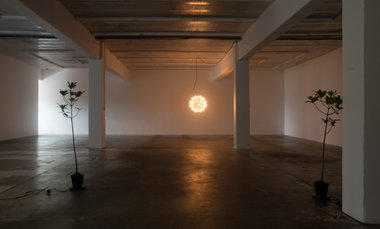
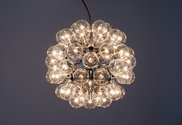
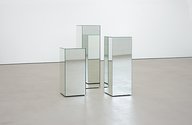
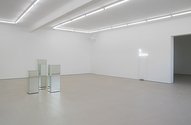
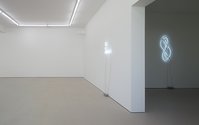


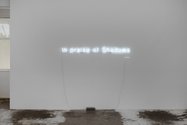

 Advertising in this column
Advertising in this column Two Rooms presents a program of residencies and projects
Two Rooms presents a program of residencies and projects



This Discussion has 2 comments.
Comment
Nicholas Haig, 5 p.m. 20 April, 2014 #
Or, John, could it not be Now Where?
John Hurrell, 12:51 a.m. 21 April, 2014 #
You have a point, Nicholas. Like a crossword where 'w' is used twice? Good thinking. I missed that.
Something else popped into my mind after I wrote this review. I remembered that amongst the field recordings of ieae are spy satelite recordings with number sequences being read out: cyptic codes. Fits in tightly with the transmit/receive theme.
Participate
Register to Participate.
Sign in
Sign in to an existing account.